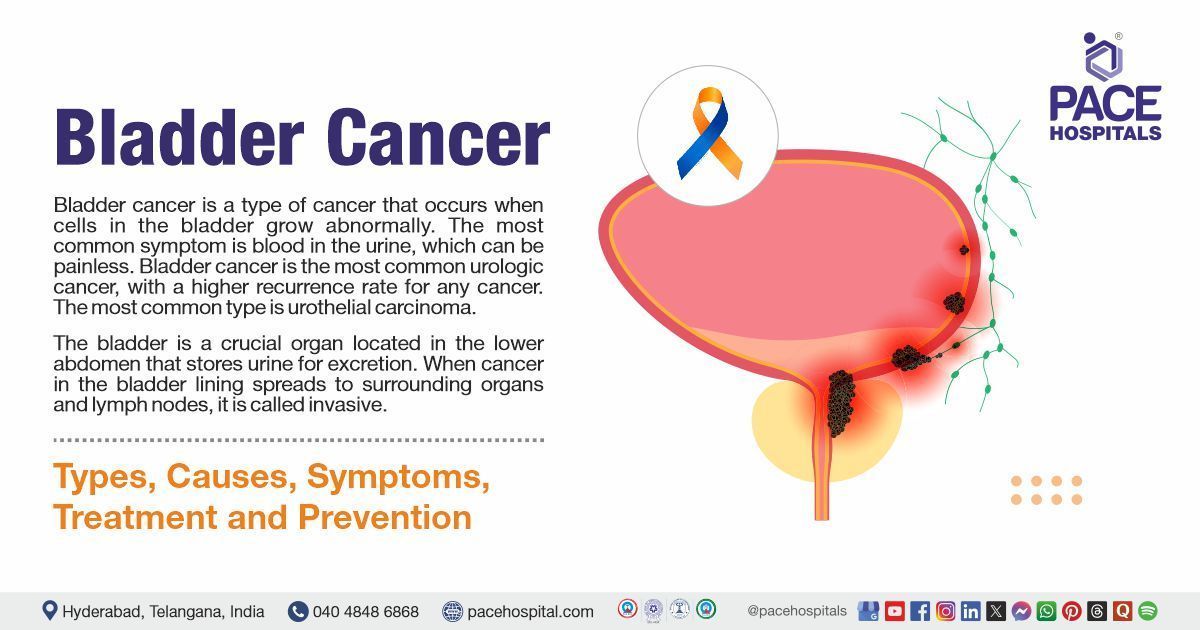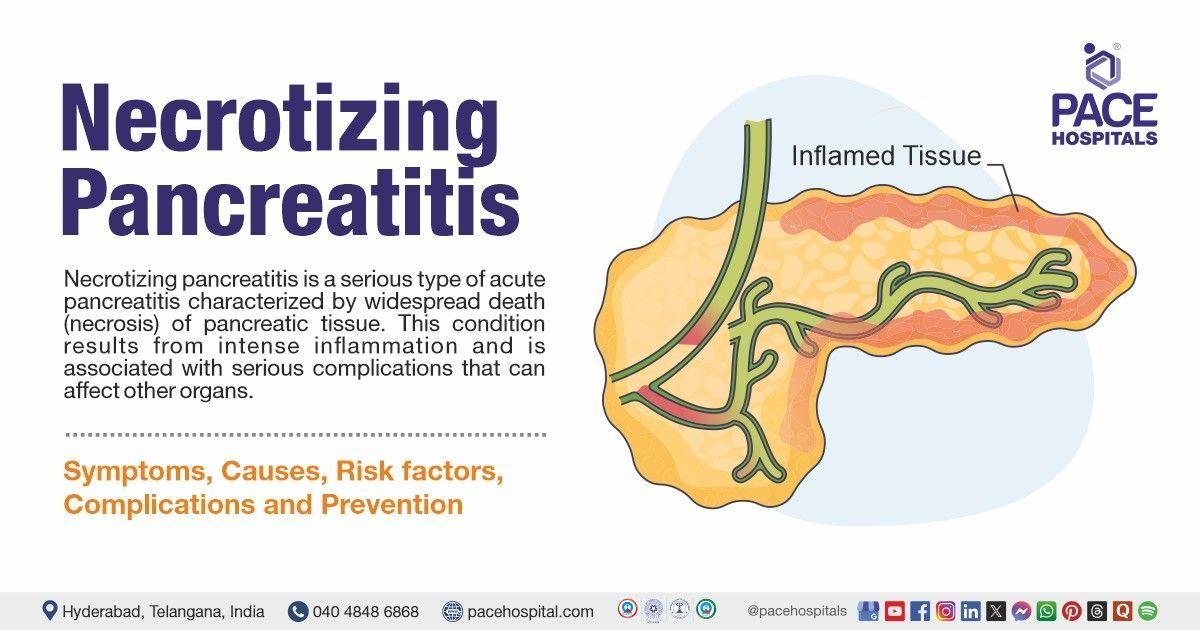Bladder Cancer: Types, Causes, Symptoms, Diagnosis, Treatment & Prevention
Bladder cancer definition
Bladder cancer is a type of cancer that occurs when cells in the bladder grow abnormally. The most common symptom is blood in the urine, which can be painless.
Bladder cancer is the most common urologic cancer, with a higher recurrence rate for any cancer. The most common type is urothelial carcinoma.
The bladder is a crucial organ located in the lower abdomen that stores urine for excretion. When cancer in the bladder lining spreads to surrounding organs and lymph nodes, it is called invasive.
Based on the treatment options, the multidisciplinary team that treats bladder cancer may include a urologist for urinary and reproductive issues, a radiation oncologist for cancer treatment, and a medical oncologist for overall cancer management and care.
Bladder cancer meaning
The term "bladder cancer" can be broken down into two components,
Bladder: The word "bladder" comes from the Old English "blædre," which is derived from Proto-Germanic *bladrą, meaning "bladder" or "pouch."
Cancer: The word "cancer" comes from the Latin "cancer," meaning "crab" or "tumour." The term was used by the ancient Greek physician Hippocrates (around 400 BCE) to describe tumours, likely due to the appearance of the blood vessels around the tumour resembling the legs of a crab. The Latin word "cancer" itself is derived from the Greek word "karkinos," which also means "crab." Over time, "cancer" became associated with malignant growths.
Bladder cancer statistics
Bladder cancer statistics worldwide
Bladder cancer ranks as the ninth most prevalent cancer worldwide. According to the World Health Organization, the prevalence of bladder cancer worldwide has led to more than 600,000 individuals being diagnosed in 2022, with over 220,000 dying from the condition. Bladder cancer is among the most difficult and expensive cancers to detect and treat.
Bladder cancer prevalence in India
According to GLOBOCAN 2020 data, bladder cancer is the 17th most common cancer in India, with a higher prevalence in males than females, with a male to female ratio of approximately 4:1. It is regarded as very widespread among Indian men, particularly those over the age of 60.
Types of bladder cancer
Bladder cancer is categorized into several types based on the cells from which it arises and its growth patterns. The different types of bladder cancer include:
Urothelial carcinoma
This type of bladder cancer is the most prevalent and is also referred to as transitional cell carcinoma. Urothelial cells are able to stretch and shrink as the bladder fills and empties.
Squamous cell carcinom
This type of cancer originates in the flat, thin cells that line the bladder, which are known as squamous cells. It can develop after long-term irritation or infection. Squamous cell carcinoma is more common in some parts of the world, including Africa and Asia.
Adenocarcinoma
This type of cancer develops in glandular cells that produce mucus in the bladder. It's a rare and aggressive type of bladder cancer.
Small cell carcinoma
This type of cancer originates in neuroendocrine cells, which are nerve-like cells that produce hormones. It is one of the rare types of bladder cancer.
Sarcoma
This type of cancer is very rare and starts in the connective tissues in the bladder.
Urachal cancer
Urachal cancer is a rare and aggressive type of bladder cancer that originates in the urachus, a fibrous remnant of the umbilical cord. It is usually an adenocarcinoma and frequently occurs in an advanced stage.

Bladder cancer symptoms
Bladder cancer can cause a wide range of symptoms, some of which are easily overlooked. Knowing the early warning symptoms, such as blood in the urine or frequent urination, can help to detect the cancer in its early stages.
Symptoms of bladder cancer include the following:
- Blood in urine: The most common symptom, which can appear suddenly and without pain. It can look like streaks of blood or turn the urine brown.
- Frequent urination: Patients might feel like they need to urinate right away, even when your bladder isn't full.
- Pain: Patients might feel pain in the lower back, abdomen, or bones.
- Burning sensation: The patients might feel a burning sensation when they urinate.
- Trouble emptying your bladder: Individuals with bladder cancer might have trouble urinating or have a weak urine stream.
- Urinating at night: Bladder cancer patients might have to get up to urinate many times during the night.
- Weight loss: Patients may lose weight unintentionally.
- Fatigue: Patients may feel tired or weak.
- Swelling in the feet: Patients may experience swelling in the feet.
Early symptoms of bladder cancer
In the initial stages, bladder cancer symptoms may be subtle and easy to overlook. One of the most common early symptoms of bladder cancer is blood in urine (hematuria), which may appear as pink, red, or dark-colored urine.
These symptoms often comes and goes and might not always be accompanied by pain. In some cases, people may notice frequent urination or feel an urgent need to urinate, even though the bladder isn't full.
Early signs of bladder cancer in women and early symptoms in females may include more frequent urinary tract infections (UTIs) or a feeling of discomfort during urination. Women over 50 should be particularly vigilant for these symptoms, as bladder cancer incidence tends to increase with age.
These symptoms could be apparent in men with bladder cancer, as men are more likely to be diagnosed than women. Men's bladder cancer symptoms frequently include pelvic or lower abdomen pain, which can be confused with other disorders such as prostate issues.
Advanced bladder cancer symptoms
As bladder cancer progresses to more advanced stages, additional symptoms may emerge. In stage 2 and stage 3 bladder cancer, the tumor may grow into deeper layers of the bladder wall, leading to more severe symptoms, such as:
- Constant or increasing pain in the lower abdomen or back
- Fatigue and general weakness due to the spread of cancer or anemia
- Swelling in the legs or feet caused by blocked lymphatic drainage
In stage 4 bladder cancer, which is the most advanced stage, the cancer has likely spread to other parts of the body. The symptoms at this stage may include significant weight loss, bone pain, and further blood in the urine. At this point, bladder cancer last stage symptoms may include more systemic signs, such as nausea, vomiting, and difficulty breathing.
Bladder cancer causes
Bladder cancer is caused by mutations (changes) in the bladder cells. It is frequently associated with exposure to specific chemicals, although the exact cause is unknown. There are a number of factors that have been found to significantly raise the risk of bladder cancer.
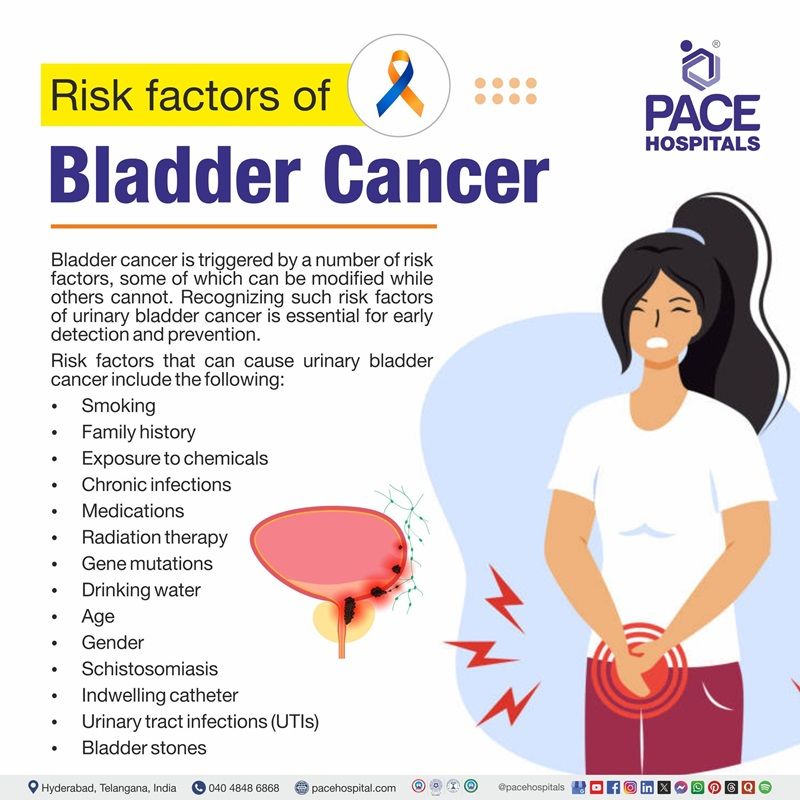
Bladder cancer risk factors
Bladder cancer is triggered by a number of risk factors, some of which can be modified while others cannot. Recognizing such risk factors of urinary bladder cancer is essential for early detection and prevention.
Risk factors that can cause urinary bladder cancer include the following:
- Smoking
- Family history
- Exposure to chemicals
- Medications
- Radiation therapy
- Gene mutations
- Drinking water
- Age
- Gender
- Schistosomiasis
- Indwelling catheter
- Urinary tract infections (UTIs)
- Bladder stones
Smoking: Smoking exposes the bladder to carcinogens in tobacco smoke, which are absorbed into the bloodstream and then filtered by the kidneys into the bladder, increasing the likelihood of bladder cancer over time.
Family history: A family history of bladder cancer raises the risk of developing the disease due to inherited genetic abnormalities or shared environmental exposures, making a person more vulnerable to bladder cancer.
Exposure to chemicals: Chronic exposure to industrial chemicals, such as aromatic amines present in dyes, rubber, and paint, can lead to cellular abnormalities and an increased risk of bladder cancer.
Medications: Certain medications, like cyclophosphamide, are known to increase the risk of bladder cancer by damaging bladder cells and causing DNA mutations, particularly with long-term or high-dose use.
Radiation therapy: Radiation therapy, especially to the pelvic area for other cancers, can damage bladder tissue over time. This damage leads to mutations and increases the risk of developing bladder cancer years later.
Gene mutations: Mutations in specific genes, such as FGFR3 or TP53, can disrupt normal cell growth and repair mechanisms, leading to uncontrolled cell proliferation and the development of bladder cancer over time.
Drinking water: Contaminated drinking water, particularly with substances like arsenic, increases the risk of bladder cancer by introducing carcinogenic compounds into the body, which are then filtered and concentrated in the bladder.
Age: As age increases the risk of bladder cancer increases, due to the accumulation of genetic mutations, long-term exposure to carcinogens, and a weakened immune system make older individuals more susceptible to cancer development.
Gender: Men are more likely to be diagnose with bladder cancer than women due to differences in anatomy, lifestyle factors (such as smoking), and hormonal influences that increase the risk of bladder cancer in men.
Schistosomiasis: Schistosomiasis, caused by parasitic infection, leads to chronic bladder inflammation and scarring. This persistent irritation increases the risk of developing bladder cancer, particularly in areas where the disease is common.
Indwelling catheter: Long-term use of an indwelling catheter can cause chronic bladder irritation, infection, and inflammation, which can cause changes in the bladder lining and raise the risk of bladder cancer.
Urinary tract infections (UTIs): Recurrent UTIs can cause chronic inflammation and irritation in the bladder lining. Over time, this can cause cellular changes and mutations, raising the risk of developing bladder cancer.
Bladder stones: Chronic bladder stones can continuously irritate and inflame the bladder lining. Bladder cancer develops as a result of this ongoing damage, which additionally raises the possibility of cellular mutations.
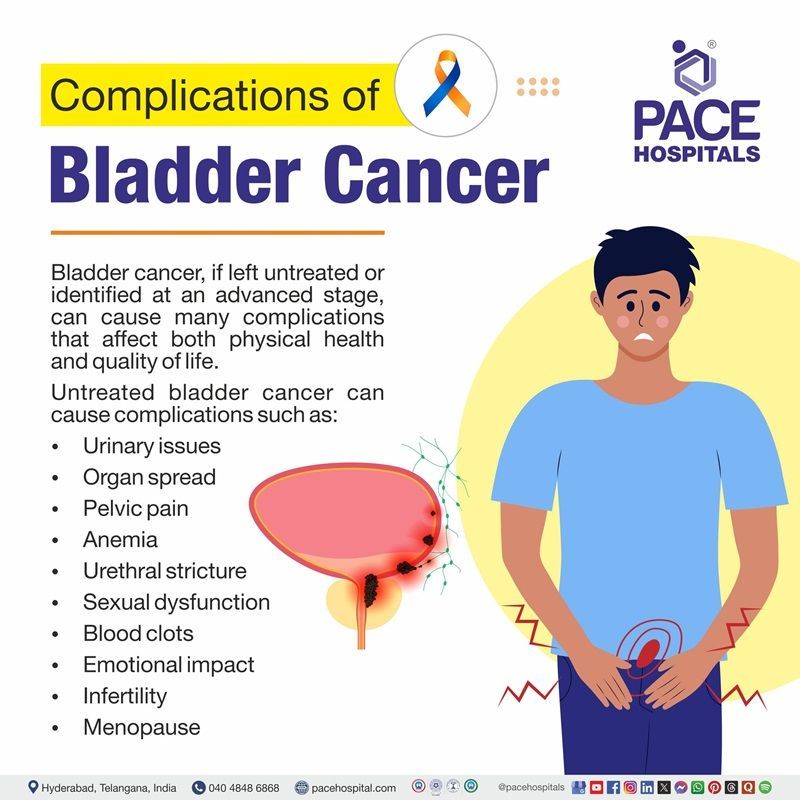
Complications of bladder cancer
Bladder cancer, if left untreated or identified at an advanced stage, can cause many complications that affect both physical health and quality of life.
Untreated bladder cancer can cause complications such as:
- Urinary issues
- Organ spread
- Pelvic pain
- Anemia
- Urethral stricture
- Sexual dysfunction
- Blood clots
- Emotional impact
- Infertility
- Menopause
Urinary issues: Bladder cancer can cause frequent urination, painful urination, or incontinence. Tumor growth can obstruct the urinary system or irritate the bladder lining, resulting in pain, inadequate bladder emptying, and an increased risk of infection.
Organ spread: If bladder cancer starts metastasizing, it may spread to surrounding organs such as the liver, lungs, or bones. This secondary spread may cause additional complications, including organ dysfunction, severe pain, and reduced treatment options, leading to poorer prognosis.
Pelvic pain: As bladder cancer progresses, tumors may spread to surrounding tissues, such as the bones, muscles, and nerves in the pelvis. This can have a major influence on daily activities and general health by causing persistent pelvic pain, discomfort when moving, and pain during sexual activity.
Anemia: Anemia, a common complication of bladder cancer, often arises from chemotherapy, blood loss from tumors, or nutritional deficiencies. Anemia causes fatigue, dizziness, and weakness due to the body’s inability to produce red blood cells adequately to carry oxygen.
Urethral stricture: Tumors or surgical treatments can lead to scarring and narrowing of the urethra, a condition known as urethral stricture. This causes difficulty with urination, pain, a weak urine stream, and can lead to urinary retention or infections.
Sexual dysfunction: Bladder cancer and treatments of bladder cancer, such as radiation or surgery can damage nerves and tissues responsible for sexual function. This can cause erectile dysfunction, vaginal dryness, pain during intercourse, and reduced libido, significantly affecting quality of life.
Blood clots: Bladder cancer treatment or the disease itself can raise the risk of blood clots, especially after surgery or chemotherapy. These clots can block blood flow, causing consequences like deep vein thrombosis (DVT) stroke and pulmonary embolism.
Emotional impact: Bladder cancer can have a profound emotional impact, often causing anxiety, depression, and feelings of isolation. Concerns about the cancer returning, the side effects of treatment, and changes in lifestyle can significantly affect mental well-being and quality of life both during and after treatment.
Infertility: Radiation, chemotherapy, or surgery for bladder cancer may damage reproductive organs, resulting in infertility. Men may experience a decline in sperm production, whereas women may develop ovarian malfunction or uterine damage, limiting their ability to conceive.
Menopause: Bladder cancer treatments, such as chemotherapy or pelvic radiation, can induce early menopause in women. This can cause hot flashes, night sweats, irregular periods, and a decrease in estrogen levels, affecting bone health and causing other hormonal imbalances.
Bladder cancer is often diagnosed at a later stage, making it difficult to cure. Treatment for bladder cancer can also cause complications.
Bladder cancer diagnosis
Urinary bladder cancer is generally diagnosed early due to visible symptoms such as blood in the urine and frequent urination. Early diagnosis is important for selecting the most effective treatment strategy and improving overall prognosis. The step by step diagnostic approach for bladder cancer includes the following:
- Medical history review: In the medical history review for bladder cancer, health care experts inquire about symptoms like blood in urine, frequent urination, and pelvic pain. The healthcare experts also evaluate risk factors such as smoking, chemical exposure, and family history of cancer etc.
- Physical examination: The healthcare expert will physically examine the abdomen and pelvic region to check for signs of abnormal growth, pain, or tenderness. Physical examination may also include a digital rectal exam (for men) to assess any signs of cancer spread to nearby organs.
- Urine tests: Urine tests are essential for detecting abnormalities, identifying malignant cells, and determining the general health of the urinary system. The health care expert may recommend urine tests such as:
- Urinalysis
- Urine cytology
- Urine biomarkers
- Cystoscopy: A small camera (cystoscope) is inserted through the urethra into the bladder to directly examine the bladder lining.
- Imaging tests: Imaging tests can be performed to detect blockages and tumors, as well as to see if cancer has spread to other organs. Imaging tests for bladder cancer include:
- CT scan (Computed Tomography):
- MRI (Magnetic Resonance Imaging)
- Ultrasound
- Intravenous pyelogram
- Biopsy: If abnormal cells are found during cystoscopy, a biopsy is conducted to remove a small tissue sample for further testing. Pathology examines the tissue sample to confirm cancer and determine its type.
- Staging: Once the diagnosis is confirmed, staging tests are performed to determine the metastasis (local, regional, or distant spread). Staging may involve: CT scans or PET scans to check for metastasis (spread to other organs like the liver or lungs). Bone scans if there is suspicion of bone involvement.
- Final diagnosis: Based on the assessment medical history, physical exam, urine tests, cystoscopy results, imaging, and biopsy findings, the healthcare expert confirms the diagnosis of bladder cancer. The cancer will be staged (e.g., superficial, invasive, or metastatic) to guide treatment decisions.
Bladder cancer treatment
Bladder cancer treatment depends on the stage, grade, and location of the tumor, as well as the patient's overall health. Here are the most common treatment approaches:
Surgery
- Cystectomy: In cases of more advanced cancer, a partial or radical cystectomy may be required. A partial cystectomy removes only the tumor and surrounding tissue, while a radical cystectomy removes the entire bladder. For men, this may also involve removal of the prostate, and for women, removal of the uterus, ovaries, and part of the vagina.
- Transurethral resection of bladder tumor (TURBT): This procedure is most commonly used for bladder cancer during early stages. A cystoscope is used to remove tumors from the bladder via the urethra, without the need for external incisions.
Chemotherapy
- Intravesical chemotherapy: For non-muscle invasive bladder cancer, chemotherapy drugs are directly administered into the bladder through a catheter. This helps destroy cancer cells and prevent recurrence.
- Systemic chemotherapy: In cases of muscle-invasive or metastatic bladder cancer, chemotherapy may be given intravenously to target cancer cells throughout the body. Common drugs include cisplatin, methotrexate, and gemcitabine.
Immunotherapy
Immunotherapy is a cancer treatment technique that uses medications and vaccinations to activate the immune system's natural capacity to fight cancer, similar to how it fights infections.
Radiation therapy
Radiation is often used alongside chemotherapy in advanced cases or when surgery is not possible. It targets and eliminates cancer cells while causing minimal damage to adjacent healthy tissue.
Targeted therapy
Targeted drugs, such as erdafitinib and ramucirumab, are used to specifically target mutations and abnormal proteins that contribute to cancer cell growth.
Palliative care
For advanced-stage bladder cancer, palliative treatments may be used to relieve symptoms, improve quality of life, and manage pain.
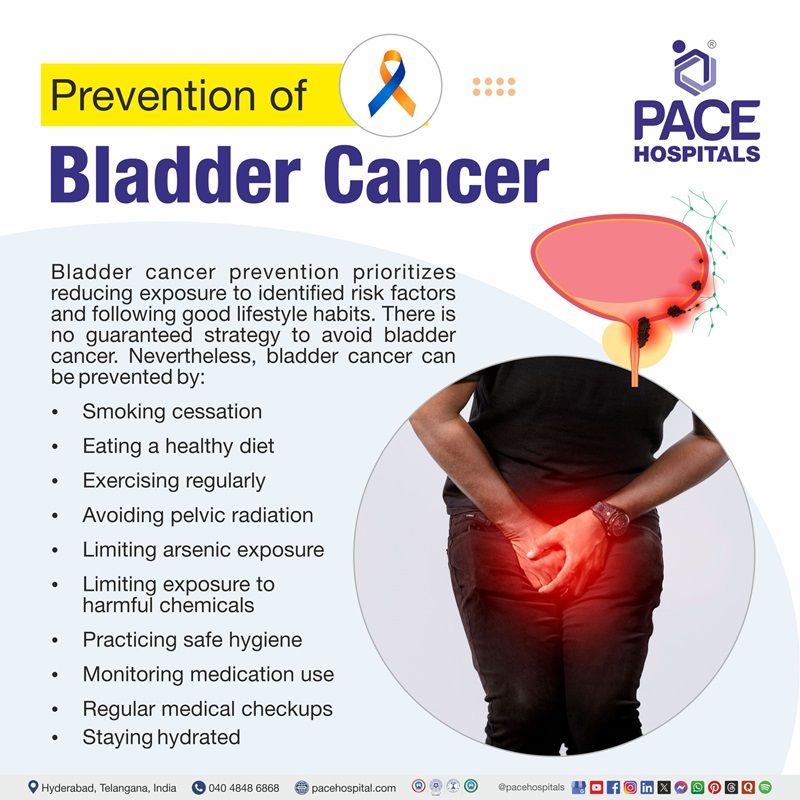
Bladder cancer prevention
Bladder cancer prevention prioritizes reducing exposure to identified risk factors and following good lifestyle habits. There is no guaranteed strategy to avoid bladder cancer. Nevertheless, bladder cancer can be prevented by:
- Smoking cessation: Quit smoking to drastically reduce bladder cancer risk. Tobacco chemicals damage the bladder lining, making smokers three times more likely to develop this cancer.
- Eating a healthy diet: Eating fruits, vegetables, and whole grains provides antioxidants that protect cells, and minimizing processed meats reduces the risk of cancer.
- Exercising regularly: Stay active to maintain a healthy weight. Regular exercise boosts immunity and reduces inflammation, which lowers the risk of bladder cancer.
- Avoiding pelvic radiation: Reduce unnecessary pelvic radiation exposure. High amounts can harm bladder tissue and increase the risk of cancer over time.
- Limiting arsenic exposure: Ensure your drinking water is arsenic-free. Use water filters or treated sources to avoid this carcinogen linked to bladder cancer.
- Limiting exposure to harmful chemicals: Avoid prolonged contact with industrial chemicals like aromatic amines. Using protective gear and following safety protocols can minimize exposure in high-risk workplaces.
- Practicing safe hygiene: Maintain good hygiene, especially if using catheters or prone to infections. Chronic bladder irritation can increase cancer risk.
- Monitoring medication use: Discuss medication risks with your doctor. Drugs like pioglitazone or cyclophosphamide may increase bladder cancer risk; alternatives or monitoring may help.
- Regular medical checkups: Schedule routine checkups if you have risk factors like family history. Early detection improves outcomes and helps manage potential risks.
- Staying hydrated: Drinking plenty of water every day dilutes toxins in urine, which reduces bladder discomfort and the risk of developing cancer.
- Knowing one’s own risk factors: Understand personal risks like age, gender, or genetics. Awareness helps tailor prevention strategies and catch symptoms early for better outcomes.
Difference between Urothelial cancer and Bladder cancer
Urothelial cancer vs bladder cancer
Urothelial and bladder cancers are frequently mistaken; however, they differ significantly. Urothelial cancer affects the entire urinary tract, whereas bladder cancer affects the bladder lining. Understanding these differences contributes to more accurate diagnosis and treatment.
| Aspect | Urothelial cancer | Bladder cancer |
|---|---|---|
| Definition | Cancer that arises from the urothelial cells (transitional epithelium) lining the urinary tract. | Cancer that specifically arises from the lining of the bladder. |
| Location | Can occur in any part of the urinary tract, including the bladder, ureters, and renal pelvis. | Specifically occurs in the bladder. |
| Histology | Urothelial carcinoma (UC) is the most common type but can include variants like squamous cell carcinoma. | Predominantly urothelial carcinoma but typically refers to cancers of the bladder alone. |
| Symptoms | May cause symptoms like haematuria, pelvic pain, or urinary tract obstruction, depending on location. | Most commonly presents with haematuria (blood in urine), painful urination, and frequent urination. |
| Risk factors | Smoking, exposure to chemicals, chronic infections, and use of certain medications. | Smoking, occupational exposure to chemicals, and chronic bladder infections. |
| Prognosis and treatment | Treatment depends on the site (ureter, kidney, or bladder), and options include surgery, chemotherapy, and radiation. | Treatment typically involves surgery (cystectomy), chemotherapy, immunotherapy, and radiation, with a focus on bladder preservation. |
Frequently Asked Questions (FAQs) on Bladder cancer
Is bladder cancer curable?
Bladder cancer can be considered curable, particularly when detected early, because most bladder cancers are highly treatable and can often be completely removed with surgery, however, even early-stage cancers can recur (return), necessitating close monitoring after treatment.
Does smoking causes bladder cancer?
Smoking can cause bladder cancer because the chemicals present in tobacco smoke damage the cells in the bladder lining. These compounds are carcinogenic, which means they can trigger mutations (changes) in cells.
What is the survival rate of bladder cancer?
The overall 5-year survival rate for bladder cancer is between 77 and 78%, with the rate varying significantly depending on the stage of the cancer at diagnosis, with early stage cancers having much higher survival rates than advanced stages; for example, localized bladder cancer has a 5-year survival rate of around 71%, while regional bladder cancer has a 5-year survival rate of around 39%.
Will urinary bladder cancer spread quickly?
While some types of bladder cancer spread quickly, most bladder cancers, particularly the most common type (urothelial carcinoma), do not. The rate of spread is largely determined by the grade of the cancer, with high-grade cancers spreading faster than low-grade cancers.
Why bcg is given in cancer bladder?
BCG (Bacillus Calmette-Guérin) is given for bladder cancer because it acts as an immunotherapy, stimulating the body’s immune system to destroy cancer cells within the bladder; essentially, it "trains" the immune system in the bladder lining to recognize and fight cancer cells by directly introducing a weakened form of bacteria into the bladder.
Is metastatic bladder cancer curable?
No, metastatic bladder cancer is generally not considered curable because it has spread to other parts of the body. Current treatments are mostly focused on controlling the disease and reducing its course, rather than finding a complete cure.
Does bladder infection cause cancer?
While repeated urinary tract infections (UTIs) do not generally cause bladder cancer, they can raise the risk. UTIs can induce inflammation, which weakens the protective layer of the bladder cells and provides an ideal environment for cancer cells.
Can cancer come back after bladder removal?
Yes, even after bladder removal (cystectomy), bladder cancer can still return, particularly in the remaining urethra or other parts of the urinary tract, Therefore, a person who has had their bladder removed still needs to be monitored for potential recurrence and should attend follow-up appointments with their health care experts on a regular basis.
Bladder cancer, particularly in its early stages, rarely causes significant pain; the most common symptom is blood in the urine (hematuria), which is usually painless. However, as cancer progresses, symptoms such as painful urination, lower back pain, or pelvic pain may develop, depending on the stage and location of the tumor.
While bloating is not a common symptom of bladder cancer, it can develop in rare situations, particularly when the cancer has spread to other places of the body, causing urine retention, or as a side effect of some cancer treatments.
Can bladder cancer cause constipation?
Yes, bladder cancer can cause constipation, though it is not a direct effect. In some cases, a large bladder tumor can compress nearby bowel structures, resulting in bowel obstruction and constipation, especially if the cancer has spread to nearby areas such as the pelvic region; additionally, bladder cancer treatments, such as radiation therapy, can contribute to constipation as a side effect.
What happens to the cells in bladder cancer?
Bladder cancer occurs when cells lining the bladder develop genetic mutations that cause them to grow abnormally and rapidly multiplying out of control, forming a tumor that can invade and destroy surrounding tissue; these abnormal cells can also break away and spread to other parts of the body if not treated.
Can bladder cancer be cured if caught early?
Intestinal cancer can spread locally to nearby tissues, regionally to lymph nodes, or distantly through the bloodstream or lymphatic system, affecting the liver, lungs, peritoneum, and bones. Metastatic cancer requires systemic treatment such as chemotherapy or targeted therapy.
Can bladder cancer cause death?
Yes, bladder cancer can be fatal, especially if it is detected late. If the cancer spreads to surrounding organs or distant parts of the body, treatment becomes more difficult, and the prognosis deteriorates. However, if detected early and treated correctly, bladder cancer can often be successfully managed, resulting in a high survival rate.
Request an appointment
Fill in the appointment form or call us instantly to book a confirmed appointment with our super specialist at 04048486868
Appointment request - health articles
Thank you for contacting us. We will get back to you as soon as possible. Kindly save these contact details in your contacts to receive calls and messages:-
Appointment Desk: 04048486868
Whatsapp: 8977889778
Regards,
Pace Hospitals
Hitech City and Madinaguda
Hyderabad, Telangana, India.
Oops, there was an error sending your message. Please try again later. We will get back to you as soon as possible. Kindly save these contact details in your contacts to receive calls and messages:-
Appointment Desk: 04048486868
Whatsapp: 8977889778
Regards,
Pace Hospitals
Hitech City and Madinaguda
Hyderabad, Telangana, India.

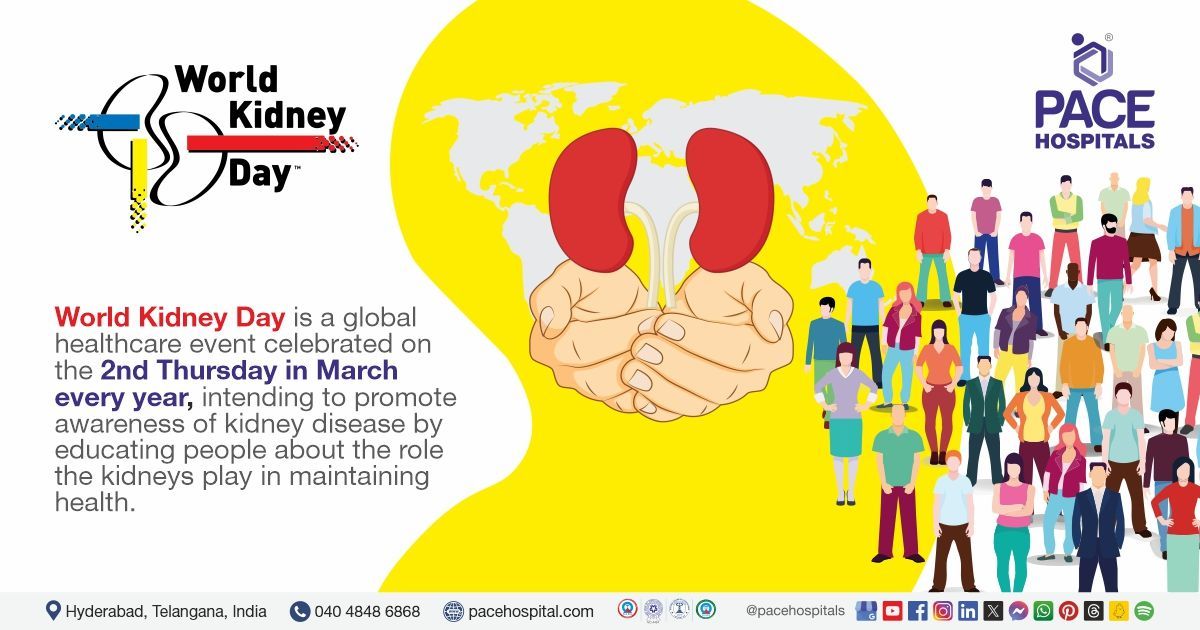
Our Locations
Metro Pillar Number C1772, Beside Avasa Hotel, Hitech City Road, Near HITEC City Metro Station, Hyderabad, Telangana, India.
Mythri Nagar, Beside South India Shopping Mall, Hafeezpet, Madeenaguda, Hyderabad, Telangana, India.
040 4848 6868
Payment in advance for treatment at PACE Hospitals, Hyderabad, Telangana, India (Pay in INR ₹)
For Bank Transfer:-
- Bank Name: HDFC
Company Name: Pace Hospitals
A/c No.50200028705218
IFSC Code: HDFC0000545 - Bank Name: STATE BANK OF INDIA
Company Name: Pace Hospitals
A/c No.62206858997
IFSC Code: SBIN0020299
Scan QR Code by Any Payment App (GPay, Paytm, Phonepe, BHIM, Bank Apps, Amazon, Airtel, Truecaller, Idea, Whatsapp etc).

CONTACT US
Call: +914048486868
WhatsApp: +918977889778
Email: info@pacehospitals.in
FOLLOW US
SUBSCRIBE
Subscribe to our newsletter and stay updated with the latest health information.
Subscribe to PACE Hospitals' Public Newsletter
Thank you for subscribing to PACE Hospitals' Newsletter. Stay updated with the latest health information.
Oops, there was an error. Please try again submitting your details.
ABOUT US
QUICK LINKS
SPECIALITIES
Disclaimer
General information on healthcare issues is made available by PACE Hospitals through this website (www.pacehospital.com), as well as its other websites and branded social media pages. The text, videos, illustrations, photographs, quoted information, and other materials found on these websites (here by collectively referred to as "Content") are offered for informational purposes only and is neither exhaustive nor complete. Prior to forming a decision in regard to your health, consult your doctor or any another healthcare professional. PACE Hospitals does not have an obligation to update or modify the "Content" or to explain or resolve any inconsistencies therein.
The "Content" from the website of PACE Hospitals or from its branded social media pages might include any adult explicit "Content" which is deemed exclusively medical or health-related and not otherwise. Publishing material or making references to specific sources, such as to any particular therapies, goods, drugs, practises, doctors, nurses, other healthcare professionals, diagnoses or procedures is done purely for informational purposes and does not reflect any endorsement by PACE Hospitals as such.

